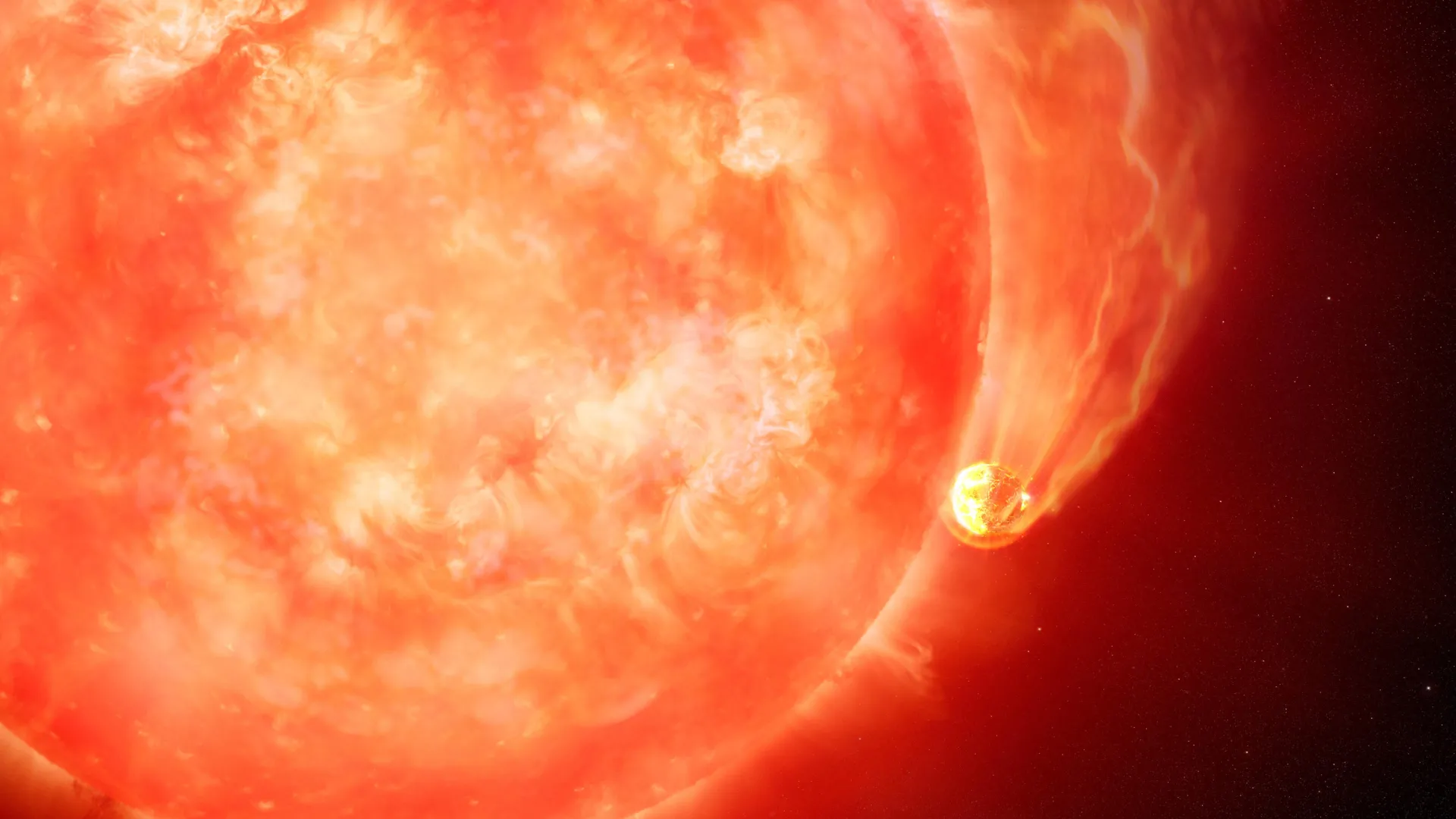Astronomers discover dying stars eating their planets
- Date:
- November 6, 2025
- Source:
- University College London
- Summary:
- Astronomers have discovered that aging stars may be devouring their closest giant planets as they swell into red giants. Using NASA’s TESS telescope to study nearly half a million stars, scientists found far fewer close-orbiting planets around older, expanded stars—clear evidence that many have already been destroyed.
- Share:

A new study from astronomers at UCL (University College London) and the University of Warwick suggests that aging stars may be destroying the giant planets orbiting closest to them.
When stars like the Sun exhaust their hydrogen fuel, they begin to cool and expand, transforming into red giants. For our Sun, this dramatic phase is expected to occur in roughly five billion years.
The research, published in the Monthly Notices of the Royal Astronomical Society, analyzed nearly half a million stars that had recently entered this "post-main sequence" stage of evolution.
Searching for Planets Around Evolving Stars
The team identified 130 planets and potential planet candidates (i.e., that still need to be confirmed) orbiting closely around these aging stars, including 33 new candidates never detected before.
They found that such planets were far less common around stars that had expanded and cooled enough to qualify as red giants (i.e., those further along in their post-main sequence evolution). This pattern suggests that many of these planets may already have been destroyed.
Evidence of Planetary Destruction
Lead author Dr. Edward Bryant (Mullard Space Science Laboratory at UCL and the University of Warwick) explained: "This is strong evidence that as stars evolve off their main sequence they can quickly cause planets to spiral into them and be destroyed. This has been the subject of debate and theory for some time but now we can see the impact of this directly and measure it at the level of a large population of stars.
"We expected to see this effect but we were still surprised by just how efficient these stars seem to be at engulfing their close planets."
According to Dr. Bryant, the destruction occurs through a powerful gravitational struggle known as tidal interaction. As a star grows and expands, these forces intensify. "Just like the Moon pulls on Earth's oceans to create tides, the planet pulls on the star," he said. "These interactions slow the planet down and cause its orbit to shrink, making it spiral inwards until it either breaks apart or falls into the star."
What It Means for the Solar System
Co-author Dr. Vincent Van Eylen (Mullard Space Science Laboratory at UCL) added perspective: "In a few billion years, our own Sun will enlarge and become a red giant. When this happens, will the solar system planets survive? We are finding that in some cases planets do not.
"Earth is certainly safer than the giant planets in our study, which are much closer to their star. But we only looked at the earliest part of the post-main sequence phase, the first one or two million years of it -- the stars have a lot more evolution to go.
"Unlike the missing giant planets in our study, Earth itself might survive the Sun's red giant phase. But life on Earth probably would not."
To carry out their research, the team used data from NASA's Transiting Exoplanet Survey Satellite (TESS). They employed an algorithm to identify small, repeated dips in starlight caused by planets passing in front of their stars. Their focus was on giant planets with short orbits (i.e., taking no more than 12 days to circle their star).
Starting with more than 15,000 possible signals, the researchers used rigorous checks to eliminate false positives, ultimately narrowing the list to 130 confirmed or candidate planets. Of these, 48 were already known, 49 were known candidates awaiting confirmation, and 33 were completely new discoveries.
Fewer Planets Around Older Stars
The researchers found that stars further along in their evolution were significantly less likely to host nearby giant planets. The overall occurrence rate was just 0.28%, with younger post-main sequence stars showing a higher rate (0.35%) comparable to main sequence stars. The most evolved stars -- those classified as red giants -- showed a sharp drop to 0.11%. (For this analysis, the smallest 12 of the 130 identified planets were excluded.)
Using TESS data, astronomers can estimate a planet's size (radius). To confirm whether these objects are true planets or low-mass stars or brown dwarfs ("failed stars" that never ignited nuclear fusion), their mass must be determined.
This is done by measuring the tiny shifts in the motion of the host star caused by a planet's gravitational pull. These "stellar wobbles" allow scientists to infer the planet's mass.
Dr. Bryant added: "Once we have these planets' masses, that will help us understand exactly what is causing these planets to spiral in and be destroyed."
The research was supported by the UK Science and Technology Facilities Council (STFC).
Story Source:
Materials provided by University College London. Note: Content may be edited for style and length.
Journal Reference:
- Edward M Bryant, Vincent Van Eylen. Determining the impact of post-main-sequence stellar evolution on the transiting giant planet population. Monthly Notices of the Royal Astronomical Society, 15 October 2025 DOI: 10.1093/mnras/staf1771/8286899
Cite This Page: